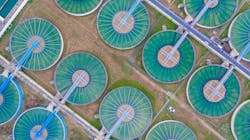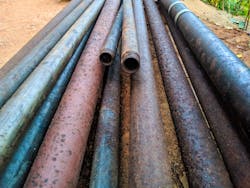A clear consensus has emerged among water sector officials about the passage of the bipartisan Infrastructure Investment and Jobs Act (IIJA) toward the end of 2021: it’s a big deal.
“It represents some of the most significant investments from the federal government ever in clean water utilities — really exceeded only by the construction grants program back in the ‘70s and the ‘80s,” said Kristina Surfus, managing director of government affairs for the National Association of Clean Water Agencies (NACWA). The group represents the nation’s publicly owned wastewater and stormwater management agencies.
President Joseph Biden signed the $1.2 trillion IIJA, also called the Bipartisan Infrastructure Bill, into law on Nov. 15, 2021. Alongside major investments in transportation, electric vehicles, internet, and roads, the legislation earmarks $55 billion for clean water and water infrastructure projects.
Much of the funding will come through the Clean Water State Revolving Fund (CWSRF) and the Drinking Water State Revolving Fund (DWSRF). Both programs are federal-state partnerships that provide communities with low-cost financing for water infrastructure projects. Each program will receive $11.7 billion over five years.
“Unlike what was passed in the 2008 American Recovery and Reinvestment Act, which was to help bolster the economy as it was cratering — and that funding was intended for shovel-ready projects — this funding is going to be [allocated] over the next five years and it’s going to be designed to modernize our economy and our infrastructure,” said Steve Dye, legislative affairs director for the Water Environment Federation (WEF).
The $23 billion investment into the two state revolving funds will be made available on top of the programs’ annual funding levels already in place.
Dye added that the new law requires SRF programs to provide up to 30 percent (and not less than 10 percent) of their funding as grants and principal forgiveness loans. Half of these grants/loans then must also be set aside for rural and financially distressed communities. Additionally, these state programs won’t have to provide a 20 percent match to receive the federal SRF funding allocation under the new rules.
Ben Frech, government affairs manager for the National Groundwater Association (NGWA), said the bill puts $10 billion toward PFAS remediation, with $5 billion earmarked for small and disadvantaged communities.
“[It is] quite a large investment, but for a very big problem,” he added.
Furthering the EPA’s focus on lead service line replacement, the new law also includes $15 billion to support lead removal projects.
Tommy Holmes is legislative director for the American Water Works Association (AWWA). He said those funds will come with no matching or cost-share requirements for states or local governments.
Holmes added that the money can go toward efforts like identification of lead pipes, as well as the planning and design of new projects, instead of just the direct removal of lead pipes.
The IIJA also reauthorizes the EPA Sewer Overflow and Stormwater Reuse Municipal Grants at $1.4 billion, with a quarter of that money earmarked for rural and financially distressed communities.
The Bill also includes several programs aimed at making water utilities more sustainable and resilient to environmental disasters. Those programs include:
- $125 million to the Alternative Source Water Pilot Program, which provides communities with grants to pay for water recycling projects.
- $120 million to the Wastewater Energy Efficiency Grant Pilot Program, which will fund projects that create or improve waste-to-energy systems.
- $125 million to the Clean Water Infrastructure Resiliency and Sustainability Grant Program, an EPA project to help communities strengthen the resiliency of their publicly owned treatment works against natural hazards.
Many water leaders agree that America’s water infrastructure has a deep need for the caliber of investments called for in the new law.
“As we sit here today, there’s something like 1,500 drinking water systems in noncompliance and serious violation of the Safe Water Drinking Act,” said Rob Powelson, president and CEO of the National Association of Water Companies (NAWC), which represents investor-owned and privately held water companies in the US.
While this influx of new funding is great, how can utilities go about getting these dollars?
“Review the legislation,” Surfus said. “Review what’s coming down. Go through the bill and then start talking with your state agencies, because these dollars are going to go through the SRFs. States are going to be looking to what’s on their intended use plans for using this funding.”
Dan Hartnett is chief advocacy officer for legislative and regulatory affairs for the Association of Metropolitan Water Agencies (AMWA). He said that each state will have a priority list of projects up for SRF funding.
“Getting projects on those lists is really the first step to make sure you have a shot at funding for these new appropriations,” he said.
Dye also urged potential applicants to communicate with state permitting authorities about their projects.
“They’re very busy these days, lots going on,” he said. “Just like everybody else in our economy right now, they’re short staffed and overworked. And this new money is going to put a lot of pressure on them.”
Though the EPA has not yet issued guidance on the application process, the allotment of the first $7.4 billion in funding was made on Dec. 2, 2021. More detailed information about the application process and requirements is expected to come in early 2022.
“Once we have that [information], we’ll have a better picture of the guidance and flow of these funds,” Holmes said.
One area that is clear is that all projects funded by new legislation must use American-made components.
“The new Buy America requirements apply to all federal agencies and sectors,” said Vanessa Leiby, executive director of the Water and Wastewater Equipment Manufacturers Association (WWEMA). “[This includes] drinking water and wastewater, and for both loans and grants. All processes, from melting to coating [for iron and steel], must be done in the US. It can’t leave the country and come back. In addition, the new requirements apply to all manufactured goods and an expanded list of construction materials, including PVC.”
During a webinar hosted by WaterWorld in December, she said that with the global nature of today’s economy, this directive creates a significant burden. Borrowers will need to be under full compliance with the new requirements within six months of enactment (May 15, 2022). Borrowers requesting waivers may also need to navigate a new waiver process.
Build Back Better Plan
On the heels of the IIJA’s passage came the passage of a $2.2 trillion version of the Build Back Better Act on Nov. 21, 2021, in the House of Representatives. The Plan is a sweeping package that includes universal pre-K, reduction of prescription drug prices and expansion of health insurance subsidies.
Water infrastructure provisions outlined in the legislation include: $10 billion for lead remediation, $1.85 billion for sewer overflow and stormwater reuse grants, and $225 million to reduce water rates for low-income customers.
Democrats hoped the bill would clear the Senate in January 2022, but West Virginia Senator Joe Manchin (D) made a surprise announcement on Dec. 19, 2021, saying that he could not support the legislation, leaving the measure’s fate unclear.
Other Items to Watch
The federal government took a significant step concerning lead and copper regulation in 2021. After reviewing the Lead and Copper Rule as part of an executive order, the EPA announced in December that there are significant opportunities for improvement, and it will take a two-pronged approach to strengthen the regulatory framework.
Beginning Dec. 16, the Revisions to the Lead and Copper Rule will go into effect to advance critical lead service line inventories to achieve 100 percent removal of lead service lines in the US. The agency plans to issue guidance on the rule, including best practices, case studies, and templates to help develop lead service line inventories. The EPA will also develop a new proposed rule, called the Lead and Copper Rule Improvements.
In addition to lead, high-profile attacks on critical infrastructure in 2021 have brought security and cybersecurity concerns to the forefront. Surfus said several committees have held hearings on the topic. They are working to advance legislation, she said, but it’s unclear which way Congress will move.
Hartnett also said that some versions of the Defense Authorization Act would require water systems and other infrastructure entities to report security incidents to the Department of Homeland Security (DHS).
“We want to make sure that, if there are any mandates coming on water systems from DHS in particular, they don’t overlap or interfere with any of the work that the water system is doing with EPA in terms of cybersecurity,” he said.
While an aging workforce continues to be a challenge throughout the water sector, one portion of the IIJA reauthorizes an EPA program that will help bring in workers to water utilities. The Innovative Water Infrastructure Workforce Program gives grants to labor organizations and nonprofits working with water utilities to set up workforce training programs that can then be emulated throughout the country. Regardless of what comes out of Congress in the next year, these pieces of legislation have guaranteed that 2022 will be a year of massive water infrastructure investments.
“Some people say ‘well, you’ve got a trillion-dollar problem, so what’s $55 billion mean?’ Well, $55 billion is a starting point: it’s a recognition by the administration that we’ve got to make these investments,” Powelson said. WW
Published in WaterWorld magazine, January 2022.





